Bolgppst for Jan 15
We started our day as usual, with breakfast. While we were there, we learned about the conditions surrounding the death of the King at Yendi. 16 years ago, he was assassinated by political rivals. While there was substantial evidence pointing to the perpetrators and potential involvement by members of the Ghanaian government, they were never prosecuted for their crimes. Thus, the funeral was delayed until now, January 2019, when tensions have subsided enough for the ceremony to take place.
We then began our four-hour drive toward Pikworo Slave Camp, which is located in Nania. On our way there, we took a break so people could use the restroom. Between Navrongo and Paga (two villages we encountered on our way to Pikworo), Prof. Abdulai made sure we noted the high density of gas stations along the 5 mile stretch of highway. A grand total of 20 gas stations was recorded, and they are thought to play a role in the illegal distribution of gasoline between Ghana and Burkina Faso.
We arrived at Pikworo Slave Camp. Temperatures at the time of our arrival were over 100 degrees, and there was little shade at the site. We met our guide, Richard Azumah and began our tour. The camp was established by a slave raider called Bagau in 1704. He kept his place of origin a secret. Later on, the camp was utilized by such slave Raiders as Babatu and Samori. We were first shown the trees where slaves were shackled from dawn until dusk. From there, we clambered onto a rocky plateau, which is speculated to have served as the slaves’ “dining hall.”
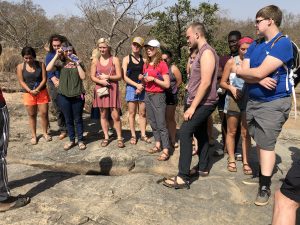
A cleft in the stone provided a year-round supply of water. This source would make the site ideal for a slave camp, as water in this region can be scarce. Nearby, there were dimples in the rockface that are believed to have served as bowls for slaves’ meals.
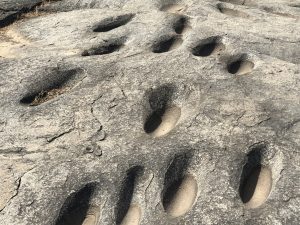
These bowls were carved out by the slaves themselves; larger bowls were used by more slaves. It was also mentioned that slaves at this camp were not bathed prior to their sale to middlemen who would march them to Salaga. From this area, we were led to the “entertainment center” where the slaves allegedly would provide entertainment to their peers in the form of their traditional songs and dances. However, our guide also mentioned that the masters composed songs for the slaves to sing, and that were made to praise those holding them in captivity. To some of us, this seemed odd, to say the least. A rock, which could be struck to provide different pitches, served as a replacement for traditional drums.
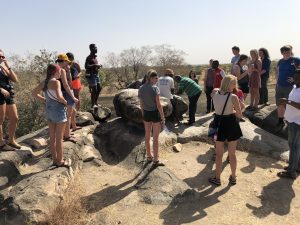
The masters believed that the entertainment boosted morale amongst the slaves and kept them from trying to escape, whether by fleeing or by taking their own lives. Following a performance by local villagers on the drumming-rock, we were taken to the area where slaves were likely traded by raiders to slave-runners in exchange for arms and trinkets.
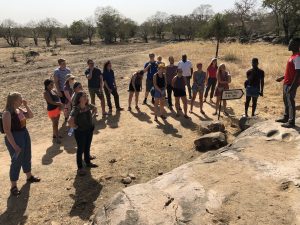
The area was a large, flat rock, overlooked by a ridge where the auctioneer could call prices and buyers could inspect the captives. We moved from this area to what is believed to have been a “lookout point,” which was a naturally-formed stone structure from which the whole of the camp could surveilled.
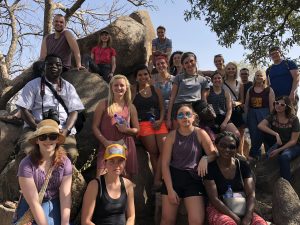
The main enemies faced by the raiders, according to our guide, were locals from the village who sought to free the slaves—if they were defeated (which apparently, they were at every instance), they were taken as slaves themselves.
We moved down from the position to a clearing that served as a mass gravesite for slaves. Rocks, placed in circles around a central stone, marked the grave of five to six slaves. Multiple grave-markers were scattered about the site. Like at Salaga, the slaves buried here did not receive the proper funeral rites required in the traditional African belief system, and therefore could not commune with their ancestors.
In this area, it is believed that their souls, trapped in our realm, disturb the living, and various traditions must be performed to put them at ease. Lastly, we were shown what is thought to be the “punishment rock,” where slaves were chained down and forced to watch the sun during the daytime, often going blind in the process.
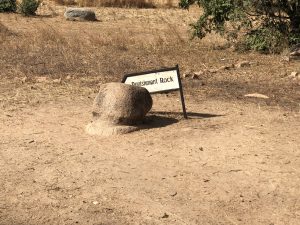
Other slaves would be made to watch them suffer for their offenses against the masters. Upon a slave’s third visit to the rock, they would be executed and added to the mass grave. Many of the students considered Pikworo to be the most moving slave site that we have visited during our time in Ghana.
Much of this site, while moving, requires us to consider the information provided to us not just as tourists, but as students. Paga and Nania are believed by many to be the first stop from the interior to the coast, where slaves would have been brought to various colonies. The Diasporic tourism industry based in Southern Ghana often omits the events and realities faced by the people of the underprivileged Northern regions. Additionally, little to no archaeological research has been performed at Pikworo and other slave monuments, likely due to lack of adequate funding from the government and general sense of shame surrounding the slave industry of antiquity. At times, the stories told at these sites must rely on oral histories, which can be influenced by memories and descriptions of the slave experience in other areas, like the United States, Caribbean Islands and Brazil.
From Pikworo, we moved to the Paga Chief Crocodile pond, where for GHC 15 for a chicken, to be given to the croc and an additional entrance fee, you can take up-close photos with real crocodiles at minimal risk of dying. It took some time to lure a croc out of the water, but once it was out, our group enjoyed taking some photos with our scaly reptilian friend. Afterward, the croc was rewarded with a live chicken for its patience.
Our guide gave us a brief story on the legendary origins of the crocodile ponds and the village’s peaceful coexistence with them. In brief summary, the son of a chief, named Nave, was pursued by his murderous brothers seeking the throne which he was promised by his father, the chief of Kampala. After promising to a wild river crocodile that he and his descendants would never again harm the crocodiles, the creature brought him to safety so he could establish his own village in what is now Paga. According to our guide, the docile crocodiles are free to wander about the town, and never consume the flesh of villagers or their animal companions.
Because Paga is near the border of Burkina Faso, we took a brief stop there to see Ghana’s northern neighbor from up close.
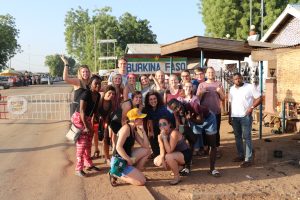
Afterwards, we started on the long road south to Tamale. Good night!
-Erin, Emily, Julia, and Matt
